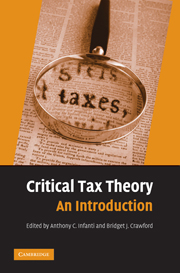Book contents
- Frontmatter
- Contents
- List of Illustrations
- List of Tables
- List of Contributors
- List of Common Abbreviations
- Introduction
- CHAPTER 1 FOUNDATIONS OF CRITICAL TAX THEORY
- CHAPTER 2 HISTORICAL PERSPECTIVES ON TAXATION
- CHAPTER 3 THE GOALS OF TAX POLICY
- CHAPTER 4 CRITICAL TAX THEORY MEETS PRACTICE
- CHAPTER 5 RACE AND TAXATION
- CHAPTER 6 GENDER AND TAXATION
- CHAPTER 7 SEXUAL ORIENTATION AND TAXATION
- Same-Sex Couples and the Federal Tax Laws
- The Internal Revenue Code as Sodomy Statute
- Heteronormativity and Federal Tax Policy
- Death Taxes: A Critique from the Margin
- Homo Sacer, Homosexual: Some Thoughts on Waging Tax Guerrilla Warfare
- CHAPTER 8 THE FAMILY AND TAXATION
- CHAPTER 9 CLASS AND TAXATION
- CHAPTER 10 DISABILITY AND TAXATION
- CHAPTER 11 GLOBAL CRITICAL PERSPECTIVES ON TAXATION
- CHAPTER 12 CRITICAL PERSPECTIVES ON CRITICAL TAX THEORY
- Index
Death Taxes: A Critique from the Margin
Published online by Cambridge University Press: 04 August 2010
- Frontmatter
- Contents
- List of Illustrations
- List of Tables
- List of Contributors
- List of Common Abbreviations
- Introduction
- CHAPTER 1 FOUNDATIONS OF CRITICAL TAX THEORY
- CHAPTER 2 HISTORICAL PERSPECTIVES ON TAXATION
- CHAPTER 3 THE GOALS OF TAX POLICY
- CHAPTER 4 CRITICAL TAX THEORY MEETS PRACTICE
- CHAPTER 5 RACE AND TAXATION
- CHAPTER 6 GENDER AND TAXATION
- CHAPTER 7 SEXUAL ORIENTATION AND TAXATION
- Same-Sex Couples and the Federal Tax Laws
- The Internal Revenue Code as Sodomy Statute
- Heteronormativity and Federal Tax Policy
- Death Taxes: A Critique from the Margin
- Homo Sacer, Homosexual: Some Thoughts on Waging Tax Guerrilla Warfare
- CHAPTER 8 THE FAMILY AND TAXATION
- CHAPTER 9 CLASS AND TAXATION
- CHAPTER 10 DISABILITY AND TAXATION
- CHAPTER 11 GLOBAL CRITICAL PERSPECTIVES ON TAXATION
- CHAPTER 12 CRITICAL PERSPECTIVES ON CRITICAL TAX THEORY
- Index
Summary
Feminist theorist bell hooks wrote many years ago that if movements were to succeed in making the world better, they ought to pay attention to the plight of the most marginalized. Thus, in the interest of justice, and in keeping with the advice of bell hooks, my critique of the death tax is from the perspective of the marginalized taxpayer, the taxpayer whose position is almost never considered by Congress in the writing of tax legislation, nor by the IRS in the interpretation of tax legislation. My marginalized taxpayer is a gay or lesbian partner in a long-term committed relationship.
I critique from this perspective not to show that gay and lesbian couples are treated less favorably than married couples by the tax law. I assume that most people will agree with me that whenever a tax rule favors traditional families, it consequentially disfavors nontraditional families, who cannot meet the necessary definitional requirements to have the rule applied to them. For those of us who agree that equality is a good principle and that justice requires treating all families alike, we might critique the estate and gift tax laws against our notion of equality. We might, for example[,] take the position that nontraditional families should be treated the same as traditional families. That is, we might adopt the principle of formal equality.
But achievement of formal equality is not the goal of my critique. In part, formal equality is not my goal because I do not begin with the conclusion that the current treatment of traditional families is necessarily just.
- Type
- Chapter
- Information
- Critical Tax TheoryAn Introduction, pp. 208 - 214Publisher: Cambridge University PressPrint publication year: 2009



